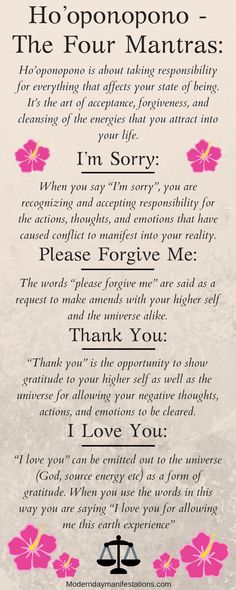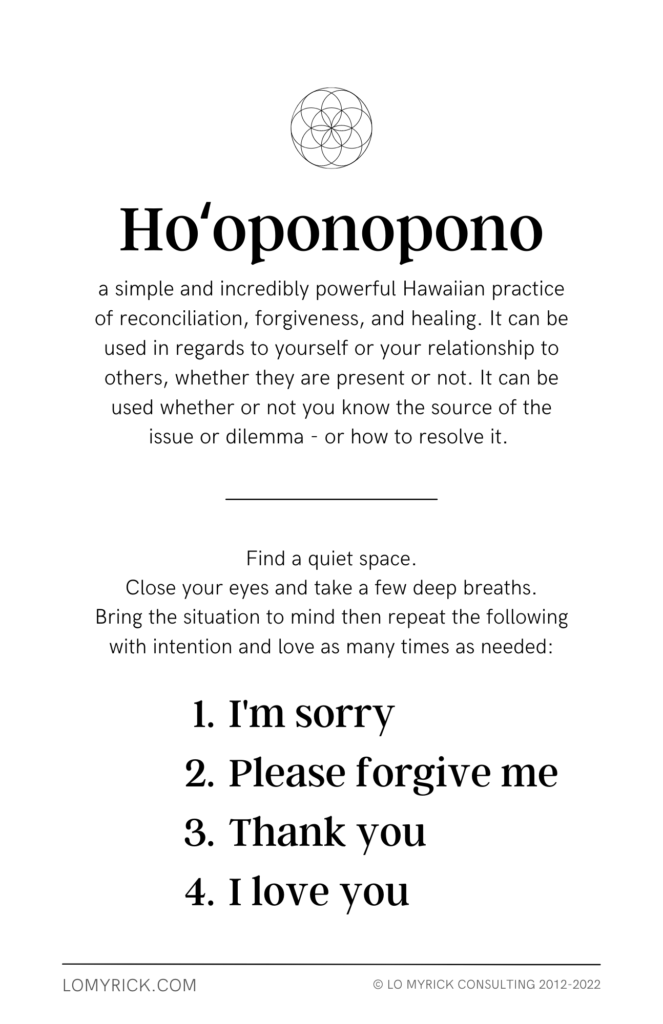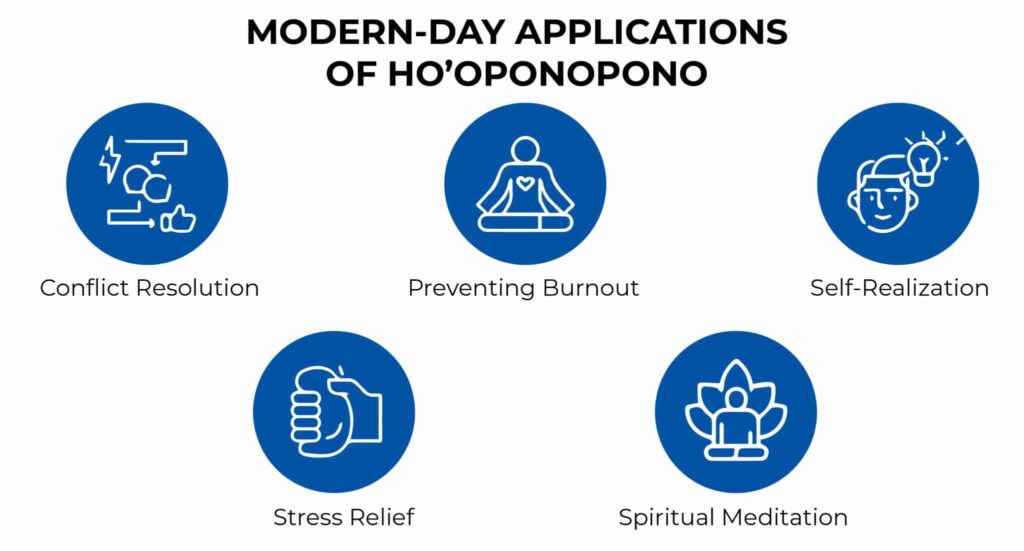Have you ever wondered how Ho’oponopono can actually assist in conflict resolution? Well, you’re in luck because in this article, we will dive deep into understanding how this ancient Hawaiian practice can help resolve conflicts in your life. Whether it’s a disagreement with a loved one, a challenging work situation, or even an internal conflict within yourself, Ho’oponopono offers a unique approach that promotes healing, forgiveness, and reconciliation. So, if you’re interested in learning more about how this practice can bring peace and resolution to your conflicts, keep on reading!
In this article, we will explore the origins of Ho’oponopono and how it is rooted in the Hawaiian culture. We will also discuss the core principles and techniques of this practice, including the concept of taking full responsibility for your own thoughts, actions, and emotions. Furthermore, we will delve into the powerful mantra used in Ho’oponopono, “I’m sorry, please forgive me, thank you, I love you” and how it can help release negative energy and promote healing. Whether you’re new to Ho’oponopono or have some prior knowledge, this article will provide you with valuable insights on how to apply this practice in your own life to resolve conflicts and foster harmonious relationships. So, stay tuned for the upcoming information and get ready to discover the transformative power of Ho’oponopono in conflict resolution!
Understanding Ho’oponopono
The Meaning and Origins of Ho’oponopono
Ho’oponopono, which means “to make right” in Hawaiian, is an ancient practice of conflict resolution and forgiveness. Originating from the traditional Hawaiian culture, this practice emphasizes the restoration of harmony and balance in relationships, both within oneself and with others.
The Principles and Beliefs behind Ho’oponopono
At the core of Ho’oponopono lies the belief that we are responsible for our experiences and the conflicts we encounter. According to this philosophy, conflicts arise from the accumulation of negative emotions, beliefs, and memories within ourselves. By taking responsibility for these conflicts, we have the power to heal and transform them.
Ho’oponopono also emphasizes the interconnectedness of all beings. It recognizes that every person has a role to play in the conflicts they face, and that the resolution lies in healing oneself and fostering understanding and forgiveness with others.
Why Ho’oponopono is Effective for Conflict Resolution
Ho’oponopono has proven to be an effective tool for conflict resolution due to its unique approach. Rather than focusing solely on external factors or trying to change others, it encourages individuals to look inward and take responsibility for their own emotions, thoughts, and actions.
By addressing the root cause of conflicts within oneself, Ho’oponopono promotes healing and transformation at a deep level. This practice allows individuals to let go of resentment, anger, and the need for control, thus creating space for resolution and understanding.
Practicing Ho’oponopono for Conflict Resolution
The Four Essential Steps of Ho’oponopono
Ho’oponopono follows a simple yet powerful four-step process for conflict resolution. These steps are:
-
Identifying and Acknowledging Conflict: The first step involves recognizing the presence of conflict and acknowledging its impact on oneself and others involved.
-
Taking Responsibility and Accountability: This step requires taking ownership of the conflict and understanding that each individual has a part to play in its creation and resolution.
-
Offering Forgiveness and Letting Go: Ho’oponopono emphasizes the power of forgiveness, both towards oneself and others. By letting go of resentments and old wounds, individuals can create space for healing and resolution.
-
Expressing Gratitude and Healing: The final step involves expressing gratitude for the lessons learned from the conflict and actively seeking healing and reconciliation.
Identifying and Acknowledging Conflict
The first step of Ho’oponopono is to identify and acknowledge the presence of a conflict. This requires honest self-reflection and awareness of one’s own emotions, thoughts, and actions. By acknowledging the conflict, individuals can begin the process of resolution and healing.
Taking Responsibility and Accountability
Ho’oponopono places great importance on taking responsibility and accountability for conflicts. It recognizes that each person involved has contributed to the conflict in some way, whether through their actions, beliefs, or emotions. By accepting this responsibility, individuals can shift their focus from blaming others to finding solutions and resolutions.
Offering Forgiveness and Letting Go
Forgiveness is a key aspect of Ho’oponopono. This practice encourages individuals to let go of resentments, grudges, and the need for control. By forgiving oneself and others, individuals can release negative emotions and create space for healing and resolution.
Expressing Gratitude and Healing
The final step of Ho’oponopono involves expressing gratitude for the lessons learned from the conflict and actively seeking healing and reconciliation. This step emphasizes the importance of acknowledging growth and transformation that can arise from conflicts.

The Benefits of Ho’oponopono in Conflict Resolution
Promoting Emotional Healing and Self-Reflection
Ho’oponopono offers emotional healing and self-reflection as its primary benefits. By addressing the root causes of conflicts within oneself, individuals can experience emotional release and healing. This practice also encourages deep self-reflection, leading to personal growth and a better understanding of one’s own beliefs and behaviors.
Improving Communication and Understanding
Another significant benefit of Ho’oponopono is its ability to improve communication and understanding in conflicts. By taking responsibility for one’s emotions and actions, individuals become more aware of how their words and behavior impact others. This increased awareness allows for more open and compassionate communication, leading to a deeper understanding and resolution.
Creating Harmonious Relationships
Ho’oponopono is particularly effective in fostering harmonious relationships. By releasing negative emotions and practicing forgiveness, individuals can cultivate compassion, empathy, and love towards others. This shift in perception creates the foundation for healthier and more harmonious relationships, reducing conflicts and promoting mutual growth.
Resolving Conflicts at their Root Cause
Ho’oponopono addresses conflicts at their root cause by focusing on self-healing and transformation. Instead of temporarily resolving surface-level issues, this practice delves deep into the underlying emotional and mental patterns that contribute to conflicts. By resolving these patterns, Ho’oponopono offers long-term solutions and prevents further conflicts from arising.
Applying Ho’oponopono Techniques in Conflict Situations
Using Ho’oponopono in Personal Relationships
Ho’oponopono can be applied effectively in personal relationships, whether it be with family members, partners, or friends. By practicing the four essential steps of Ho’oponopono, individuals can transform conflicts and foster deeper connections. This practice requires open communication, active listening, and a willingness to take responsibility for one’s actions and emotions.
Ho’oponopono in Professional and Workplace Conflicts
Ho’oponopono is not limited to personal relationships but can also be applied in professional and workplace conflicts. By applying the principles of Ho’oponopono, such as taking responsibility and expressing forgiveness, individuals can create a more harmonious and productive work environment. This practice can help resolve conflicts, improve teamwork, and foster a culture of understanding and respect.
Ho’oponopono for Interpersonal Disputes
Ho’oponopono can also be utilized in interpersonal disputes, such as disagreements between neighbors or community members. By engaging in open dialogue, practicing forgiveness, and expressing gratitude, Ho’oponopono can contribute to the resolution of disputes and the restoration of peace within communities.

Challenges and Considerations in Using Ho’oponopono for Conflict Resolution
The Need for Commitment and Consistency
One of the challenges in applying Ho’oponopono for conflict resolution is the need for commitment and consistency. This practice requires individuals to consistently apply the four essential steps and maintain an awareness of their emotions and actions. It requires a deep commitment to personal growth and healing.
Navigating Resistance and Skepticism
Another challenge is navigating resistance and skepticism from others who may not be familiar with or understand Ho’oponopono. It is important to approach conflicts with empathy and respect, allowing others to choose their path of resolution. By leading by example and practicing Ho’oponopono authentically, others may become more open to its effectiveness.
Cultural Appropriation and Respect
Ho’oponopono is deeply rooted in Hawaiian culture, and it is essential to approach this practice with respect and cultural sensitivity. As with any cultural practice, it is crucial to educate oneself, seek guidance from knowledgeable sources, and honor the origins and traditions associated with Ho’oponopono.
Seeking Professional Guidance When Necessary
In some cases, seeking professional guidance may be necessary when applying Ho’oponopono for conflict resolution. Especially in complex or deeply rooted conflicts, working with a trained therapist or mediator can provide valuable insights and support. It is essential to recognize when professional assistance is needed to ensure the best possible outcome.
Case Studies and Examples of Ho’oponopono in Conflict Resolution
Real-Life Stories of Resolving Family Conflicts
Numerous real-life stories demonstrate the power of Ho’oponopono in resolving family conflicts. In these cases, individuals have practiced the four essential steps of Ho’oponopono, leading to healing, forgiveness, and restored relationships. Families have reported strengthened bonds, increased understanding, and improved communication through their application of Ho’oponopono.
Successful Applications of Ho’oponopono in Community Disputes
Ho’oponopono has also been successfully applied to resolve community disputes. In cases where conflicts have divided neighborhoods or communities, individuals have come together to practice Ho’oponopono, engaging in open dialogue and expressing forgiveness. As a result, these communities have experienced healing, unity, and restored harmony.
How Ho’oponopono Helped Resolve Workplace Conflicts
Workplace conflicts can be particularly challenging, but Ho’oponopono has been proven effective in resolving them. By practicing the principles of Ho’oponopono, such as taking responsibility and fostering forgiveness, individuals have been able to eliminate toxic dynamics, foster trust, and promote a healthy work environment. This has led to increased productivity, teamwork, and overall employee well-being.

Critiques and Controversies Surrounding Ho’oponopono for Conflict Resolution
Criticism of Oversimplifying Complex Conflicts
One critique of Ho’oponopono is that it may oversimplify complex conflicts. While Ho’oponopono offers effective tools for resolution, it may not be suitable for every conflict scenario. In cases where conflicts involve deep-rooted systemic issues or abuse, additional support and interventions may be necessary.
Debate around the Cultural Appropriation of Ho’oponopono
There is an ongoing debate around the cultural appropriation of Ho’oponopono. As a practice deeply rooted in Hawaiian culture, it is important to approach Ho’oponopono with respect and cultural sensitivity. It is crucial for individuals to educate themselves on its origins, seek guidance from knowledgeable sources, and adopt the practice with humility and reverence.
Ethical Considerations in Adopting Ho’oponopono Techniques
Ethical considerations arise when adopting Ho’oponopono techniques. It is essential to apply this practice authentically and genuinely, rather than as a mere tool for personal gain or manipulation. Approaching conflicts with empathy, compassion, and a genuine desire for resolution is crucial in maintaining ethical integrity.
Further Resources and Support for Using Ho’oponopono for Conflict Resolution
Books and Publications on Ho’oponopono
There are various books and publications available that delve into the teachings and principles of Ho’oponopono. These resources provide in-depth explanations, case studies, and practical techniques to apply Ho’oponopono in daily life. Some recommended titles include “Zero Limits” by Joe Vitale and Ihaleakala Hew Len and “Ho’oponopono: The Hawaiian Forgiveness Ritual as the Key to Your Life’s Fulfillment” by Ulrich E. Duprée.
Workshops and Training Programs on Ho’oponopono
Workshops and training programs on Ho’oponopono offer opportunities to learn directly from experienced practitioners. These interactive sessions provide a deeper understanding of the practice, guidance on applying the four essential steps, and a supportive community of individuals on a similar path.
Online Communities and Forums for Practitioners
Online communities and forums dedicated to Ho’oponopono provide a space for practitioners to connect, share experiences, and seek guidance. These communities offer a supportive environment to discuss challenges, gain insights, and find inspiration in the application of Ho’oponopono.

Conclusion
The transformative power of Ho’oponopono in conflict resolution cannot be understated. By addressing conflicts at their root cause and taking responsibility for one’s emotions and actions, individuals can experience emotional healing, improved communication, and harmonious relationships. Ho’oponopono fosters inner and outer peace by promoting forgiveness, gratitude, and deep self-reflection. By applying the principles of Ho’oponopono authentically and with respect, individuals can navigate conflicts with compassion and find resolution in the most challenging situations.
